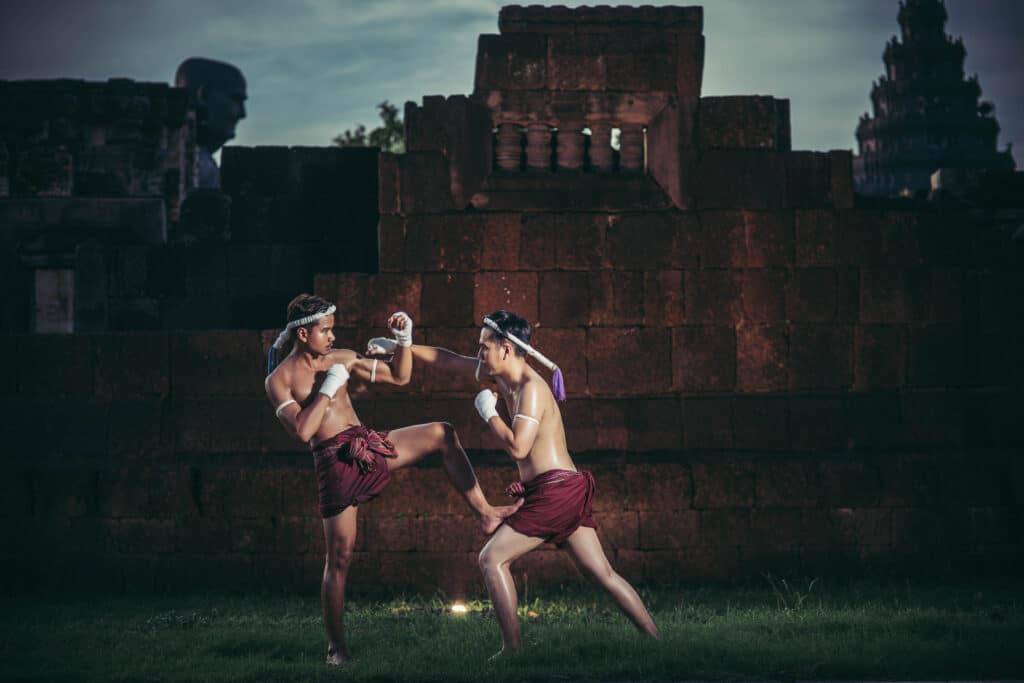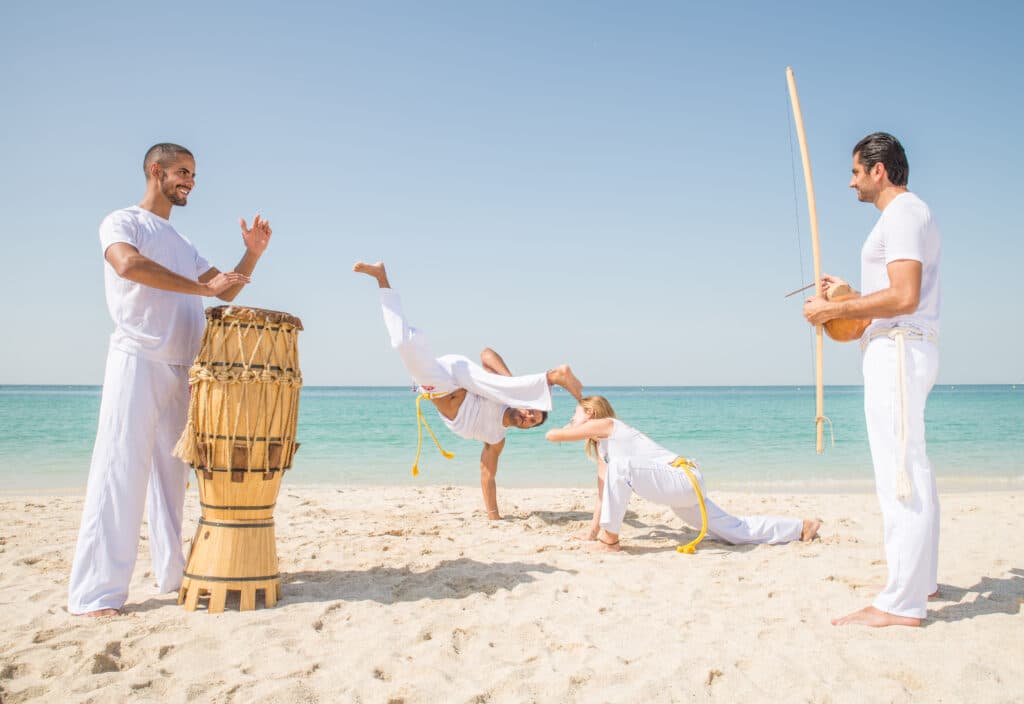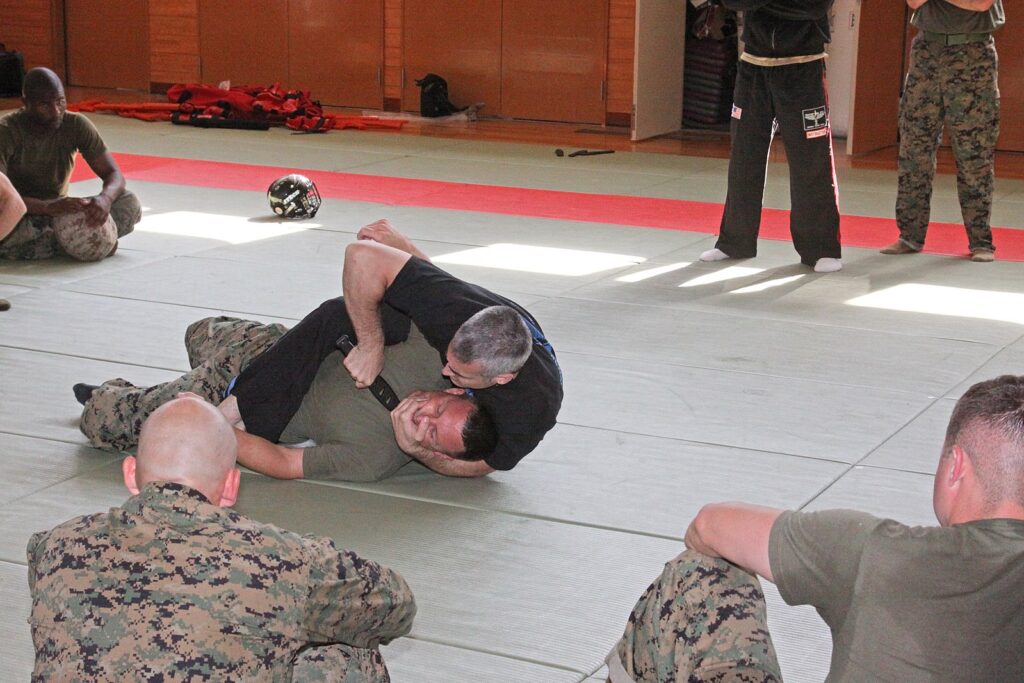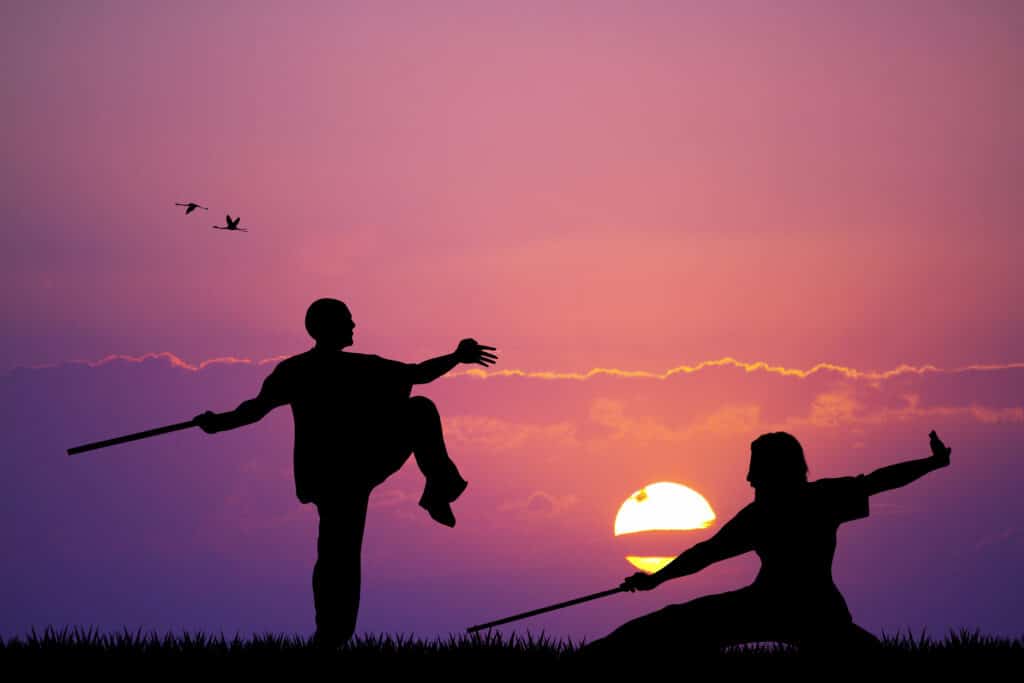
Karate, Kung fu, Thai Boxing, Tai Chi, Jujitsu, Aikido, Wing Chun, Wushu, Tang Soo Do, Taekwondo, Krav Maga, Capoeira, Kickboxing, Boxing, Arnis, Kali, Hapkido, Eskrima, and many more.
One thing is true for all of these different types of martial arts. To become proficient in any of them takes a lifetime of consistent effort. The “frequency” of your workouts should really be determined by the goals that you have set for yourself.
If you are training because you want to become more skilled in self-defense, it is imperative that you set reasonable goals for yourself before beginning your training.
Training With A Martial Arts Instructor
Before I get into this, I want to make one thing clear: I have been training with Sifu Phu for the past 27 years, but I didn’t start out as a public student. After attending public classes for one week, I decided to switch to taking private lessons instead, and that decision has remained unchanged ever since. In order to track my overall progress, I would only attend open classes.
Training Only In Martial Arts Public Classes
Therefore, it is going to take you significantly longer than you anticipate to become “decent” at your chosen martial art if you are only training as a public student and nothing else within any given martial art system. My best guess is that they spent at least ten years attending public classes at least three times per week and working out at home for at least an additional four hours per week.
Pro Tip: Training more hours a week is always better
Taking Private Lessons With A Martial Arts Master
IIn my view, this is the most effective method of exercise. I took anywhere from two to three private lessons per week on average over the course of ten years. That occurred once a week for a number of years.
I was able to do it by giving up almost everything else so that I could focus on my training. In addition to that, I frequently attended the public classes that were taught by Sifu Phu.
I also convinced some of my friends to train with me over the years so that I could put in as much time as I could into my workouts. For many years, I put in an average of 35 hours per week training in various forms of martial arts.
(In my opinion 1 good private lesson a week is equal to about a month of public lessons.)
Training Martial Arts Just Online
if you ever watched those old-school Chinese martial arts movies or any of the types of martial arts movies that come out. You will often see people learning from scrolls or books because in some cases it’s all they could get their hands on.
So while it’s not ideal to just train online it is a way for you to get going and just start training. Because the best time to start training in martial arts is always now. We wrote a really good blog post on the subject of training kung fu online you can read that here
12 Of The Most Common Martial Arts To Train In
As a resource to help you learn more about the various forms of martial arts and find the one that is right for your own goals and objectives, I’ve compiled a list of the top 12 styles in no special order, along with a brief description of each. To help you decide which martial art style is ideal for you, or your children.
1. Tai Chi

Not only is the Chinese martial art of Tai Chi practiced for its self-defense applications, but also because of the numerous positive effects, it has on one’s health. Tai Chi has its origins in China (improving muscle strength, flexibility, cardiovascular fitness, and better night’s sleep). This style frequently makes use of postures and positions that are performed in slow motion.
Tai Chi practitioners have claimed for ages that the practice’s slow-moving postures and motions were inspired by snake-fending Taoist breathing practices and birds like the crane. Even if you are being attacked, this will make it simpler for you to relax, preserve a cool demeanor, and keep a mild focus on the situation.
2. Mixed Martial Arts

Despite the fact that Mixed Martial Arts (MMA) has been more well-known in recent years thanks to fighters like Conor McGregor and Khabib Nurmagomedov, the discipline has been practiced for a very long time.
MMA, or mixed martial arts, is a combat sport that has been around since the Greco-Roman era and now has millions of fans all over the world. It is a regulated form of full-contact fighting.
In this particular fighting method, battles can take place either standing up or on the ground. A combatant has access to a wide variety of fighting styles and techniques, including grappling, hitting, choking, kicking, and punching.
The term “submission” refers to a range of different fighting techniques that can be utilized in mixed martial arts. Some of these techniques include boxing (submission), karate (submission), Jujitsu (submission), Muay Thai (submission), and Judo (submission), amongst many others.
3. Muay Thai (Thai Boxing)

The art of Muay Thai, which is also the name of Thailand’s national sport, has deep historical roots in the country. Muay Thai is Thailand’s national sport. The name “the art of eight limbs” was given to this kind of martial arts because its practitioners rely on eight points of contact when performing their techniques (hands, elbows, knees, and shins).
This approach also makes use of striking while standing and grappling with an opponent. During the execution of this technique, various parts of a person’s body are refashioned into weapons for use in combat. You can turn your hands into weapons such as a sword or a dagger, your knees into an ax, and your elbows into hammers if you’re seeking a weapon that isn’t just a sword or a dagger.
Due to the fact that this style of martial arts requires the use of both the lower and the upper body, it is essential to engage in workouts that target the entire body and focus on developing core muscles. Muay Thai Rochester MN, has a lot of health benefits, especially for women who are doing this. They can get you into shape and help you stay positive and confident.
4. Capoeira

It is believed that Angolan slaves in Brazil invented capoeira in order to conceal their expertise in martial arts by disguising it as dancing moves. Because of this, there is nonstop dancing, singing, and movement, in addition to the obvious physical conflict that accompanies it.
The most fundamental variation of capoeira consists of two capoeiristas in the center of a circle of other capoeiristas. Some of the participants will be required to play percussion instruments so that we can create an engaging musical backdrop. In spite of the rhythms that are currently in play, it is important for the combatants to make use of moves and deception.
5. Hapkido

You might already be familiar with this variation of Korean karate if you’ve practiced it before. This style’s armory includes powerful kicks, punches, joint locks, and throws, as well as strikes to a variety of pressure spots throughout the body. The Korean martial art of Hapkido places a strong emphasis on techniques that do not require the opponent to resist, such as circular and non-resisting movements.
The precise footwork and body posture that Hapkido fighters use is done for a number of reasons, one of which is to avoid using power against power. This is done in addition to gaining control of the situation.
Because of the similarities in their titles, a lot of people think that Hapkido and Aikido are founded on the same concepts, but this is not the case at all. In Hapkido, the usage of canes, ropes, and swords, among other types of weapons, can take many different forms.
When it comes to the execution of techniques, the breadth of responses available, and even the overarching idea of martial arts, this is a world away from Aikido.
6. Aikido

The Japanese martial art discipline of Aikido, which is the kind of martial arts that actor Steven Seagal uses in the majority of his movies, does not place a focus on kicking or punching the opponent. On the contrary, it teaches you to place as much focus on the safety and well-being of your opponent as you do on your own safety and well-being. When it comes to Aikido, the objective is not to triumph over one’s opponent but rather to come to some sort of amicable compromise with them.
Aikido, whose name roughly translates to “the method of harmony for the spirit,” is thought to be the most spiritual of the various styles of martial arts. Aikido practitioners often advocate that students take advantage of their adversary’s kinetic energy in order to capture control of a situation and render their adversary helpless.
As a result of this, an Aikido practitioner will engage in a greater amount of pushing actions, turning motions, and joint locks than a regular martial artist will (but only when necessary).
7. TaeKwonDo

In addition to Judo, Taekwondo is the only other martial art to be featured in the Olympic Games. It’s a Korean martial art, which makes it the national sport of South Korea.
In spite of the fact that Taekwondo and Karate are two completely different martial arts, many people confuse them. Like Karate, Taekwondo emphasizes forceful kicks, unlike Karate which emphasizes punches.
The ancient martial art of Taekwondo has grown into a fitness trend that emphasizes life values like self-control and inner power in addition to physical conditioning. However, a great level of speed, balance, stamina, and flexibility is required to perform throws, takedowns, and joint locks.
8. Krav Maga

The phrase “Combative Krav Maga,” which literally translates to “Battle Combat” in Hebrew, is utilized within the context of martial arts. This is a form of martial arts that was established in Israel in the 1930s and teaches a tactical strategy that may be used to prevent violent attacks as well as respond to them when they occur.
In spite of the fact that it places a strong focus on grappling, wrestling, and the use of hand blows, Krav Maga teaches its practitioners to use nearly any object that is available to them in order to successfully defend themselves against an attacker.
When it comes to Krav Maga, the practitioner is at liberty to employ any strategies or techniques that come to mind as being appropriate for incapacitating or vanquishing the adversary.
In spite of this, the Israeli Defense Forces have adopted Krav Maga as their primary method of self-defense. Real-world uses of this method include the fight against terrorism, the work of air marshals and special commando teams, as well as that of other law enforcement agencies.
9. Kung Fu

In spite of the fact that Kung Fu has been practiced at least as far back as the first century, Bruce Lee is primarily responsible for popularizing it in the Western world. The umbrella phrase “taijiquan” encompasses a wide variety of Chinese martial arts systems and approaches, all of which can be found here. This term also encompasses all of those systems and methods.
The origins of the Chinese martial art known as Kung Fu can be traced back to Buddhist monasteries and Shaolin temples in China during the fifth century CE. Many trace its origins back to India.
Kicks, punches, open- and closed-handed attacks, blocks, and the ability to read your opponent’s mind are all components of the martial art known as Kung Fu.
The Praying Mantis, Wing Chun, and Hung Gar are just some of the Kung Fu systems that have been extensively influenced by animal movements and traditional Chinese culture.
10. Judo

Japanese martial art The martial art known as judo is considered to be on the more contemporary side due to the fact that it was just established in 1882 and is now an Olympic sport. The art of Judo includes a wide variety of throws, some of which include joint locks, chokeholds, strangleholds, and pins.
The objective is to take down the adversary so that you may control them or render them helpless. To put it another way, this style of martial arts places an emphasis on finding ways to counteract the power that is possessed by the opponent.
The use of blows, weapons, or hand-and-foot thrusts is not permitted during free practice or competition; however, these techniques are permitted during specified forms such as the Judo Kata.
11. Jujitsu

Jujitsu is another well-known kind of Japanese martial arts, and noteworthy athletes and celebrities such as Joe Rogan, Steven Crowder, Chuck Norris, Jessica Alba, Ice T, and Ryan Phillipe are also practitioners. Jujitsu, in contrast to karate, makes use of a broad array of chokes, pins, locks, holds, and joint manipulations. Karate, on the other hand, relies mostly on punches and kicks.
In contrast to the majority of other forms of martial arts, such as karate, which instruct students on how to defend themselves by blocking attacks, Jujitsu teaches students how to subdue their attackers through various throws and joint locks. Through the use of the techniques outlined above, a practitioner of Jujitsu may, in the vast majority of cases, redirect the attacker’s force and momentum.
Because a practitioner of Jujitsu is able to easily incapacitate an attacker through the use of joint locks and other precise moves, this style of martial arts is incredibly effective but also has the potential to be deadly. Brazilian Jujitsu is one of the most well-known variations of this art, and it is notable for the emphasis it places on strangling and locking the joints of an opponent when they are on the ground.
12. Karate

Since it was developed in Okinawa at the beginning of the 20th century, it has grown to become one of the most widely practiced forms of martial arts. Karate is primarily practiced for the purposes of self-defense and developing self-discipline.
It involves a variety of strikes, including punches, kicks, open-handed hits, blocks, and the use of elbows and knees. Students are often instructed on how to defend themselves by preventing an assault from occurring in the first place rather than learning how to attack.
...What is your favorite martial art system? Let us know in the comments section below!

Leave a Reply